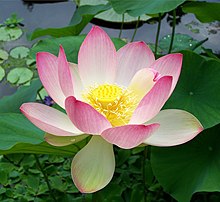| Nelumbo nucifera | |
|---|---|

| |
| Lotus flower | |
| Scientific classification | |
| Kingdom: | Plantae |
| Clade: | Tracheophytes |
| Clade: | Angiosperms |
| Clade: | Eudicots |
| Order: | Proteales |
| Family: | Nelumbonaceae |
| Genus: | Nelumbo |
| Species: | N. nucifera
|
| Binomial name | |
| Nelumbo nucifera | |
| Synonyms | |

Nelumbo nucifera, also known as Padma (Sanskrit: पद्म, romanized: Padmā, lit. 'Lotus') or Kamala (Sanskrit: कमल, lit. 'Lotus'), sacred lotus, Indian lotus,[1] or simply lotus, is one of two extant species of aquatic plant in the family Nelumbonaceae. It is sometimes colloquially called a water lily, though this more often refers to members of the family Nymphaeaceae.[2]
Lotus plants are adapted to grow in the flood plains of slow-moving rivers and delta areas. Stands of lotus drop hundreds of thousands of seeds every year to the bottom of the pond. While some sprout immediately and most are eaten by wildlife, the remaining seeds can remain dormant for an extensive period of time as the pond silts in and dries out. During flood conditions, sediments containing these seeds are broken open, and the dormant seeds rehydrate and begin a new lotus colony.
Under favorable circumstances, the seeds of this aquatic perennial may remain viable for many years, with the oldest recorded lotus germination being from seeds 1,300 years old recovered from a dry lakebed in northeastern China.[3] Therefore, the Chinese regard the plant as a symbol of longevity.
It has a very wide native distribution, ranging from central and northern India (at altitudes up to 1,400 m or 4,600 ft in the southern Himalayas[4]), through northern Indochina and East Asia (north to the Amur region; the Russian populations have sometimes been referred to as Nelumbo komarovii, with isolated locations at the Caspian Sea.[5] Today, the species also occurs in southern India, Sri Lanka, virtually all of Southeast Asia, New Guinea, and northern and eastern Australia, but this is probably the result of human translocations.[5] It has a very long history (c. 3,000 years) of being cultivated for its edible seeds[5] and is commonly cultivated in water gardens.[4] It is the national flower of India and Vietnam.
- ^ "Sacred Lotus". Encyclopædia Britannica. 4 May 2023.
- ^ Janice Glimn-Lacy, Peter B. Kaufman, Botany Illustrated: Introduction to Plants, Major Groups, Flowering Plant Families, p. 79, 2006, Springer, google books
- ^ Shen-Miller, J.; Schopf, J. W.; Harbottle, G.; Cao, R.-j.; Ouyang, S.; Zhou, K.-s.; Southon, J. R.; Liu, G.-h. (2002). "Long-living lotus: Germination and soil -irradiation of centuries-old fruits, and cultivation, growth, and phenotypic abnormalities of offspring". American Journal of Botany. 89 (2): 236–47. doi:10.3732/ajb.89.2.236. PMID 21669732.
- ^ a b Pulok K. Mukherjee; Debajyoti Mukherjee; Amal K. Maji; S. Rai; Michael Heinrich (2010). "The sacred lotus (Nelumbo nucifera)– phytochemical and therapeutic profile". Journal of Pharmacy and Pharmacology. 61 (4): 407–422. doi:10.1211/jpp.61.04.0001. PMID 19298686. S2CID 85342386.
- ^ a b c Cite error: The named reference
Zhang-2015was invoked but never defined (see the help page).